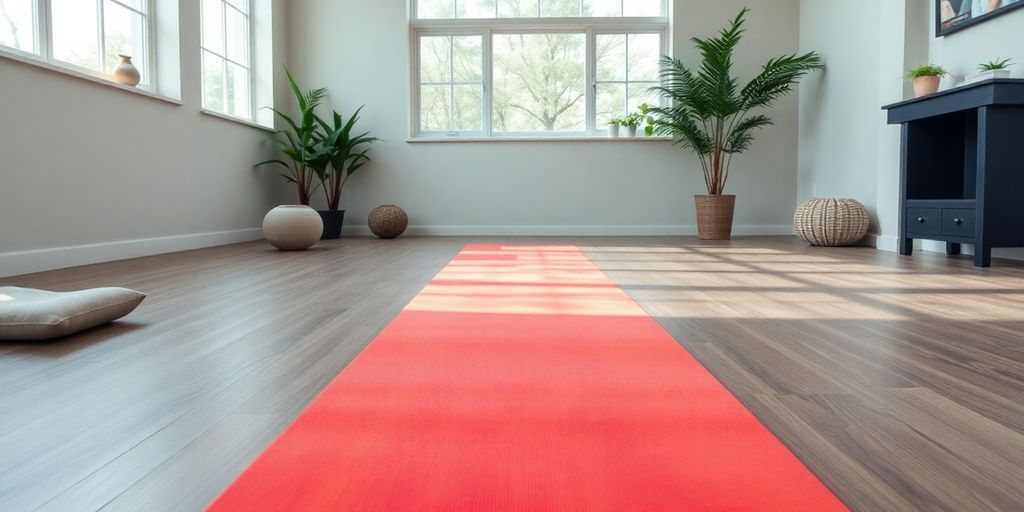
The Ultimate Guide to Choosing the Best Eco Friendly Yoga Mat for Your Practice in 2025
Picking the right eco-friendly yoga mat can feel like a big deal, especially with so many options around. These mats aren’t just about yoga; they’re about making a choice that’s good for the Earth too. In 2025, the choices are better than ever, with mats made from all kinds of natural materials. This guide is here to help you figure out what matters most when picking a mat that’s eco-friendly and perfect for your practice.
Key Takeaways
- Eco-friendly yoga mats are made from materials like natural rubber, organic cotton, jute, and hemp.
- Look for certifications like GOTS, OEKO-TEX, and FSC to ensure the mat's eco-friendliness.
- Proper care and storage can extend the life of your eco-friendly yoga mat.
- Brands like Manduka, Gaiam, and Jade Yoga are known for their sustainable mats.
- Consider factors like thickness, grip, and portability when choosing your mat.
Understanding Eco-Friendly Yoga Mat Materials
Natural Rubber: Benefits and Considerations
Natural rubber is a popular choice for eco-conscious yogis. It's harvested from rubber trees, making it a renewable resource. One of the standout features of natural rubber mats is their excellent grip, which is ideal for maintaining stability during poses. Plus, these mats are biodegradable, meaning they won't sit in a landfill for centuries. However, if you have a latex allergy, natural rubber might not be the best option for you.
Organic Cotton and Its Advantages
Organic cotton mats bring a soft and breathable surface to your practice. These mats are grown without harmful pesticides, ensuring a healthier choice for both you and the planet. Organic cotton is not only eco-friendly but also provides a comfortable cushion for your joints. If you're looking for a mat that's both gentle on the environment and on your body, organic cotton is worth considering.
Exploring Jute and Hemp Options
Jute and hemp are two materials that are gaining popularity in the eco-friendly yoga world. Jute mats are known for their durability and natural texture, which enhances grip. They're biodegradable and require minimal water and pesticides to grow, making them a sustainable choice. Hemp, on the other hand, is incredibly sturdy and long-lasting, offering a firm surface for your practice. Both materials support a sustainable lifestyle while providing the strength needed for various yoga poses.
Switching to an eco-friendly yoga mat is a small step that can lead to significant positive changes for both your health and the environment.
For those interested in exploring sustainable yoga mats, Discover the top 9 eco-friendly yoga mats for 2025 to find options that align with your values.
Certifications to Look for in Eco-Friendly Yoga Mats
When you're on the hunt for an eco-friendly yoga mat, certifications are your best friend. They ensure that the mat you're eyeing is not just green-washed but genuinely sustainable and safe for your practice. Here's a breakdown of the key certifications to keep in mind:
GOTS Certification Explained
The Global Organic Textile Standard (GOTS) is a top-notch certification for organic fibers. If your mat has this label, it means the materials are genuinely organic and meet strict environmental and social criteria. This certification covers everything from the harvesting of raw materials to environmentally and socially responsible manufacturing. So, when you see GOTS on a yoga mat, you can trust that it's made from sustainable and ethically sourced materials.
The Importance of OEKO-TEX
OEKO-TEX certification is all about safety. It guarantees that the product has been tested for harmful substances and is safe for human use. Mats with this certification are free from harmful chemicals, making them a healthier choice for your daily practice. When you spot the OEKO-TEX label, you know you're choosing a mat that's been rigorously checked for your safety.
FSC Certification for Sustainable Products
The Forest Stewardship Council (FSC) certification ensures that the materials used in the yoga mat come from responsibly managed forests. This certification promotes sustainable forestry practices, helping to protect our forests for future generations. When you see the FSC label, you can be confident that the product contributes to the preservation of our natural resources.
Picking a yoga mat with these certifications not only benefits your health but also supports sustainable and ethical practices in the industry. It's a win-win for you and the planet.
Caring for Your Eco-Friendly Yoga Mat

Cleaning Tips for Longevity
Taking care of your yoga mat is like taking care of a good friend. You want it to last and keep it in top shape. Regular cleaning is key to extending your mat's life. After each practice, wipe it down with a mild soap and water solution. If you have access to a product like The Ultimate Everyday Cleaner, it can be helpful for absorbent surfaces. Just add a few pumps to a damp sponge, apply evenly, and let it soak for a bit before rinsing. Make sure to let your mat air dry completely before rolling it up to avoid any mold or mildew.
Proper Storage Solutions
Where you store your mat matters just as much as how you clean it. Keep it in a cool, dry place, away from direct sunlight, which can break down the materials over time. Rolling it up or hanging it can help maintain its shape. If you’re always on the go, consider a carry strap for convenience. This way, your mat stays protected and ready for your next session.
Avoiding Common Mistakes
Sometimes, it’s what you don’t do that saves the day. Avoid using harsh chemicals or abrasive scrubbers on your mat, as they can damage the surface. Don’t leave your mat in a hot car or exposed to the elements for too long. Also, resist the urge to fold your mat, as this can create creases that are hard to get rid of. By keeping these simple tips in mind, your eco-friendly yoga mat will continue to support your practice for years.
Top Brands for Eco-Friendly Yoga Mats
Manduka: A Leader in Sustainability
Manduka is often hailed as a pioneer in the world of eco-friendly yoga mats. Known for their durability and performance, Manduka mats are made from sustainable materials like natural rubber and TPE. What sets Manduka apart is their commitment to reducing waste—they have a recycling program where you can send back your old mat for responsible disposal. Their PRO series, in particular, is a favorite among seasoned yogis for its dense cushioning and excellent grip.
Gaiam's Eco-Conscious Offerings
Gaiam is another brand that's made a name for itself in the eco-friendly market. Their mats are crafted from a variety of materials, including jute and TPE, offering a balance between comfort and sustainability. Gaiam's commitment to the environment extends beyond their products; they also support various environmental initiatives. Their mats are lightweight and portable, making them ideal for yogis on the go.
Jade Yoga's Commitment to the Environment
Jade Yoga takes eco-friendliness to the next level by planting a tree for every mat sold. Their mats are made from natural rubber tapped from rubber trees, providing a slip-resistant surface that's perfect for any practice. Jade Yoga mats are also known for their resilience and comfort, making them a top choice for those who care about both their practice and the planet.
Investing in a quality yoga mat not only enhances your practice but also supports brands that prioritize sustainability. Whether you choose Manduka, Gaiam, or Jade Yoga, you're making a choice that benefits both you and the environment.
For those looking for a durable and comfortable yoga mat, consider options like the Oak Yoga Mat which combines eco-friendly materials with superior performance.
Factors to Consider When Choosing Your Mat
Thickness and Comfort Levels
When picking a yoga mat, thickness is a biggie. Thicker mats give you more comfort because they cushion your joints during those long poses. But if you're into balance-heavy yoga, a thinner mat might be your jam since it lets you feel the ground better. Most mats range from 1/8 to 1/4 inch, so choose based on what feels right for you.
- 2mm: Light and easy to carry, but not much cushion.
- 4mm: A good middle ground for most practices.
- 5mm: Great for extra support and comfort.
Grip and Stability Features
A mat with a solid grip is a must, especially if you sweat a lot or practice hot yoga. Natural rubber and jute mats usually have a better grip compared to synthetic ones. Look for a mat with a non-slip surface or textured patterns to keep you steady.
Portability and Weight Considerations
If you’re always on the move, think about portability. Lightweight mats are easier to carry around, especially if you’re heading to a class. Check if the mat rolls up neatly or comes with a strap for convenience. Durability also matters; you want something that can handle being tossed in the back of your car repeatedly without falling apart.
Picking the right yoga mat isn't just about comfort—it's about finding something that fits your lifestyle. Whether you need something portable or a mat that can soak up sweat without slipping, there's an eco-friendly option out there for you. Just remember, for a non-toxic yoga experience, avoid mats made from PVC, PER, TPE, or other synthetic materials.
Budget-Friendly Eco-Friendly Yoga Mat Options

Affordable Materials to Consider
Finding a good yoga mat that won't break the bank is totally possible. Materials like TPE (Thermoplastic Elastomer) and PER (Polymer Environmental Resin) are budget-friendly and eco-conscious. These materials provide a decent grip and are lightweight, making them easy to carry around. They might not last as long as pricier options, but they’re a solid start for anyone new to yoga.
Balancing Cost and Quality
When you're on a budget, balancing cost and quality can be tricky. Here are a few things to keep in mind:
- Material Longevity: While cheaper mats might save you money upfront, investing a bit more in durable materials like natural rubber can pay off in the long run.
- Grip and Comfort: Make sure the mat provides enough grip and cushioning for your practice. You don’t want to be slipping around!
- Environmental Impact: Check for certifications that ensure the mat is made sustainably, even if it’s a cheaper option.
Opting for a budget-friendly yoga mat doesn’t mean you have to compromise on your values. Look for mats that align with both your budget and eco-friendly goals.
Where to Find Budget Options
Shopping around can uncover some great deals on eco-friendly yoga mats. Consider these places:
- Online Retailers: Websites like Amazon or local eco-friendly shops often have sales or discounts.
- Second-hand Stores: Sometimes you can find gently used mats at thrift stores or online marketplaces.
- Yoga Studios: Some studios sell mats at a discount for members or during special events.
Finding the right mat takes a bit of research, but it's worth it to find something that suits your needs while being kind to the planet.
User Reviews and Recommendations
Top-Rated Mats by Consumers
When it comes to eco-friendly yoga mats, user reviews are a goldmine of information. People love sharing their experiences, and it can be super helpful when you're trying to decide on the right mat. One of the top-rated mats is the Yogi Bare Paws deluxe mat, known for being biodegradable and vegan-friendly. It's crafted from sustainable materials, and the packaging is 100% recyclable. Another favorite is the Jade Harmony mat, praised for its quality and grip, especially among those who practice hot yoga.
Here's a quick look at some popular choices:
| Brand | Material | Average Rating |
|---|---|---|
| Yogi Bare Paws | Natural Rubber | 4.8/5 |
| Jade Harmony | Natural Rubber | 4.7/5 |
| Gaiam | Organic Cotton | 4.6/5 |
Common Praise and Criticisms
Users often highlight the durability and grip of eco-friendly mats. However, not everything is always rosy. Some common complaints include:
- Slipping: Some mats lose their grip over time, so look for ones with a textured surface.
- Wear and Tear: Regular use can lead to wear, so investing in a high-quality mat is wise.
- Thickness Issues: Some people find mats too thin, which can be uncomfortable for certain poses.
Expert Opinions on Eco-Friendly Mats
Experts in yoga and sustainability often recommend investing in eco-friendly mats. They point out that these mats not only help the planet but also offer better performance and longevity compared to their traditional counterparts.
Choosing an eco-friendly yoga mat is a step towards supporting sustainable practices and ensuring a healthier planet for future generations.
In summary, whether you're swayed by glowing reviews or expert advice, picking an eco-friendly mat is a win for both you and the environment.
Wrapping It Up: Your Eco-Friendly Yoga Mat Journey
Alright, so there you have it! Picking out an eco-friendly yoga mat isn't just about finding something to stretch on; it's about making a choice that reflects your care for the planet and your own well-being. You've got loads of options, from natural rubber to jute, and each comes with its own perks. Remember, it's not just about the mat itself but also how it fits into your lifestyle and practice. Take your time, weigh the pros and cons, and go for the one that feels right for you. And hey, by choosing a mat that's kind to the Earth, you're not just enhancing your yoga sessions—you're also doing your bit for a greener future. So, roll out that mat and enjoy your practice, knowing you've made a mindful choice!
Frequently Asked Questions
What makes a yoga mat eco-friendly?
Eco-friendly yoga mats are crafted from natural or recycled materials that are kind to the Earth. They avoid harmful chemicals and often are biodegradable.
Are eco-friendly yoga mats more costly?
They might cost a bit more upfront, but they are durable and safe, offering long-term value.
How do I clean my eco-friendly yoga mat?
Use mild soap and water to clean your mat. Keep it out of direct sunlight and store it in a cool, dry place.
Can I use an eco-friendly yoga mat for hot yoga?
Yes, many eco-friendly mats have great grip and comfort, perfect for hot yoga. Check if it's labeled for hot yoga use.
What are the top materials for eco-friendly yoga mats?
Natural rubber, organic cotton, jute, and hemp are popular choices for eco-friendly mats.
Where can I buy eco-friendly yoga mats?
You can find them online, at local eco-friendly shops, or from brands that focus on sustainable products.


